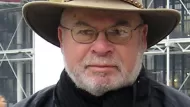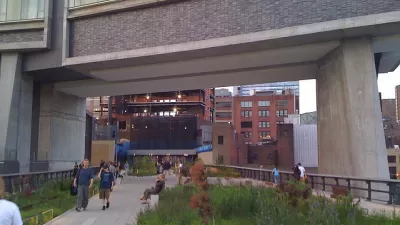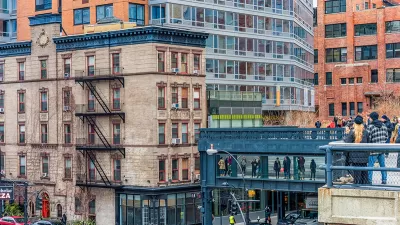The High Line curving through the west Chelsea section of Manhattan bordering the Hudson River has to be one of the most successful planning and design stories in New York City in recent years, touted as a crowning achievement of the reign of Mayor Bloomberg, to be emulated in cities across the country. Testimonials and awards not withstanding, I am wary of the cloying elitism of a crowing Bloomberg. Having followed the project’s promotions for the last decade and the community’s evolution for the last half century, I am skeptical of its heralded success. And with the recent sounding of related development controversies, a second opinion is in order.
The High Line curving through the west Chelsea section of Manhattan bordering the Hudson River has to be one of the most successful planning and design stories in New York City in recent years, touted as a crowning achievement of the reign of Mayor Bloomberg, to be emulated in cities across the country.
Testimonials and awards not withstanding, I am wary of the cloying elitism of a crowing Bloomberg. Having followed the project's promotions for the last decade and the community's evolution for the last half century, I am skeptical of its heralded success. And with the recent sounding of related development controversies, a second opinion is in order.
To be sure, the embrace of the High Line by its high stepping sponsors and a middling media makes it hard to criticize. There can be no denying the feel good publicity it has generated. Whether labeled a park or a promenade, the finical design of the former freight train spur - sensitively landscaped with sustainable plantings and mod furnishings - has become a major tourist attraction and an even more considerable real estate asset.
The elevated tracks certainly have been transformed from when I worked there as a railway inspector on the night shift on the original B&O line and in the nearby NY Central RR Yards. That was some 57 years ago when cautious cabbies did not prowl the neighborhood for fares as they do now. To know Chelsea during those days was to walk its mean streets and work on the waterfront and in the rail yards, a bailing hook at the ready. Now I only have a groaning PC.
Given the neighborhood's rough trade and its predators, I would not use "affection" to describe how I felt about the area then, flavored as it was by a bar scene catering to the S&M and transgender crowd that did not include the MBA types as it does now. "Wary" would be my more apt phrase, which actually prepared me well for my future work as a journalist and planner. It also made me appreciate the nuances of neighborhood change.
The passive open space of today's High Line design banning bikes, dogs and discouraging the slatternly, is a not so subtle disinvite to the long time residents shoe boxed into the low rent housing projects and tenements that once lent Chelsea its gritty reputation. They were considered second-class citizens then, as they are now.
The High Line obviously was not designed for these persevering dwellers, or the neighborhood. If so, from my public planning perspective, the generous funds received from its well heeled patrons and the city should have been first used at the street level, to improve pedestrian safety and connectivity, contain the noxious traffic, and purchase a few of the area's unsightly parking lots for active playgrounds, pocket parks and common gardens that have been on the community's wish list for decades.
The pleasant seating and the arresting views aside, the High Line serves principally as the meandering manicured front lawn and garden for the neighborhood's new residential and commercials developments, encouraged by a host of zoning changes and other concessions enacted by a real estate and building trade-friendly Bloomberg administration. To be sure, the project has provided needed construction jobs for the many, investment opportunities for the few, and lucrative contracts for the design team. The success of the design was coincidental.
Just check out the land prices in Chelsea, which have defied the recession to soar along with rents to about $2,000 a square foot. It has made the once unsavory fringe area now one of the most expensive in the city, a favored roost of Wall Street denizens, a short limo ride away from their offices.
Given their sobriquet as the moneyed "masters of the universe," it was therefore not surprising to hear recently of a flurry of flyers being posted in the neighborhood declaring that tourists parading to the High Line were an intrusion interfering with daily neighborhood life that was detailed as going to the store, riding a bike, taking a stroll, jogging to the gym or just having a quiet moment with their dog. "Chelsea is not Times Square," stated the flyer.
Frankly, because it is not Times Square, it does have an appeal to tourists who want to get away from the crowded midtown attractions to experience a different, slower more sociable New York neighborhood. Chelsea is convenient. There is also the enticement to some of glimpsing exhibitionists parading in full view before wide windows in a pricey hotel straddling the High Line.
Though a laudable public amenity for having inflated adjacent real estate values while spurring jobs, the High Line increasingly is being viewed by the community as a mixed blessing.
Coming to the fore recently and stirring strong protests is an ambitious $250 million plus expansion of the hugely successful upscale Chelsea Market, which attracts visitors from across the city as well as tourists. Its owners, who in the past have generously supported the High Line, want to add an office tower and hotel to the sprawling complex, and have pledged more funds for the park's operation, a gesture seen as a classic pay for play ploy popular in Bloomberg's New York. The powers-that-be love it; the neighborhood decidedly less so, declaring it over scaled and warning that its motivating greed could destroy the neighborhood.
Some feel it already has, and in its place a new Chelsea has arisen, heralded by the High Line and fashioned more in the spirit of a tony Upper East Side in an ever-changing New York.

Maui's Vacation Rental Debate Turns Ugly
Verbal attacks, misinformation campaigns and fistfights plague a high-stakes debate to convert thousands of vacation rentals into long-term housing.

Planetizen Federal Action Tracker
A weekly monitor of how Trump’s orders and actions are impacting planners and planning in America.

In Urban Planning, AI Prompting Could be the New Design Thinking
Creativity has long been key to great urban design. What if we see AI as our new creative partner?

King County Supportive Housing Program Offers Hope for Unhoused Residents
The county is taking a ‘Housing First’ approach that prioritizes getting people into housing, then offering wraparound supportive services.

Researchers Use AI to Get Clearer Picture of US Housing
Analysts are using artificial intelligence to supercharge their research by allowing them to comb through data faster. Though these AI tools can be error prone, they save time and housing researchers are optimistic about the future.

Making Shared Micromobility More Inclusive
Cities and shared mobility system operators can do more to include people with disabilities in planning and operations, per a new report.
Urban Design for Planners 1: Software Tools
This six-course series explores essential urban design concepts using open source software and equips planners with the tools they need to participate fully in the urban design process.
Planning for Universal Design
Learn the tools for implementing Universal Design in planning regulations.
planning NEXT
Appalachian Highlands Housing Partners
Mpact (founded as Rail~Volution)
City of Camden Redevelopment Agency
City of Astoria
City of Portland
City of Laramie





























